Flow Field and Temperature Field in a Four-Strand Tundish Heated by Plasma
Abstract
1. Introduction
2. Mathematic Model
2.1. Geometric Model
2.2. Meshing
2.3. Basic Assumptions and Boundary Conditions
- (1)
- The upper part of the tundish was inert gas (Ar), and the influence of the slag layer on heat transfer is not considered;
- (2)
- The chemical reaction between the phases was not considered;
- (3)
- Empirical formulas were used for heat dissipation on the wall and top of the tundish, and the second type of wall boundary conditions were used;
- (4)
- The impact of plasma gas on the molten steel level was negligible, and there was only energy exchange between plasma and molten steel.
2.4. Governing Equations
- (1)
- Continuity equation:where ρ is the density of the molten steel, and ui is the velocity of the molten steel.
- (2)
- Momentum conservation equation:where P is the static pressure, μeff is the effective viscosity; gi is the gravitational acceleration.
- (3)
- Energy equation:where T is the temperature of molten steel, λ is the thermal conductivity of molten steel; ST is the viscosity dissipation factor.
- (4)
- The standard k–ε model:where k is the turbulent kinetic energy, ε is the turbulent energy dissipation rate, Gk is the turbulence energy under the mean velocity gradient, and is decided by:
3. Results
3.1. Model Validation
3.2. Flow Field
3.3. Temperature Field
3.4. Turbulence Intensity
4. Conclusions
- (1)
- In the prototype tundish without plasma heating, the molten steel flowed out from the diversion hole and then directly flowed out from outlet 2 quickly and formed a short-circuit flow, which results in a poor flow field. The overall temperature of the prototype tundish has dropped significantly. The temperature difference between outlet 1 and outlet 2 was 1 K in 5 min. It can be noted that the temperature of the molten steel would continue to decrease which is not conductive to conduct low superheat casting under a constant speed.
- (2)
- When the molten steel in tundish heated by plasma, the flow state of molten steel changed greatly. After the three molten steel streams flowed out from the diversion holes, most of the molten steel flowed a certain distance and then flowed out from the outlet 1. It could eliminate the short-circuit flow at outlet 2. When the plasma heating was 500 kW, the molten steel at plane 2 had an obvious upward flow. The turbulence intensity was improved and distributed evenly with an increase in plasma heating power.
- (3)
- The temperature of molten steel in tundish heated by plasma was risen significantly. The temperature in the upper part of the tundish was maintained above 1793 K, and the low temperature zone at the edge of the tundish was obviously reduced. With the increase of plasma heating power, the volume of high temperature area in tundish was increased and the temperature of outlet was risen obviously. When the plasma heating power was 1000 kW and the heating time was 300 s, the temperature difference was reduced by 23.12% compared with non-plasma heating.
Author Contributions
Funding
Data Availability Statement
Conflicts of Interest
References
- Sahai, Y. Tundish technology for casting clean steel: A review. Metall. Mater. Trans. B 2016, 47, 2095–2106. [Google Scholar] [CrossRef]
- Xing, F.; Zheng, S.; Liu, Z.; Zhu, M. Flow Field, Temperature Field, and Inclusion Removal in a New Induction Heating Tundish with Bent Channels. Metals 2019, 9, 561. [Google Scholar] [CrossRef]
- Ye, M.; Zhao, M.; Chen, S.; Yang, S.; Li, J. Influence of Plasma Heating on the Metallurgical Effects of a Continuous Casting Tundish. Metals 2020, 10, 1438. [Google Scholar] [CrossRef]
- Yang, S.; Zhang, L.; Li, J.; Peaslee, K. Structure optimization of horizontal continuous casting tundishes using mathematical modeling and water modeling. ISIJ Int. 2009, 49, 1551–1560. [Google Scholar] [CrossRef][Green Version]
- Zhi, J.; Zheng, Y.; Cui, J.; Tian, N.; Wu, X.; Xu, A. Temperature measurement and analysis for continuous casting tundish in Baosteel. Iron Steel 2002, 37, 26. [Google Scholar]
- Zhao, M.J.; Yang, S.F.; Li, J.S.; Xi, X.J.; Zhang, X.L.; Wang, Y.H.; Chen, Y.F. Effect of plasma heating on the molten steel in Tundish. In Materials Science and Technology 2019; Materials Science and Technology: Portland, OR, USA, 2019. [Google Scholar]
- Pan, X.F. Numerical simulation of non-steady fluid flow and heat transfer in continuous casting tundish during series casting. China Metall. 2010, 20, 8. [Google Scholar]
- Zuo, Q.W.; An, X.; Yang, J.B.; Cang, D.Q. Effects of over heat and casting speed on quality of GCr15 billet. Adv. Mater. Res. 2014, 3356. [Google Scholar] [CrossRef]
- Sun, H.B.; Zhang, J.Q. Macrosegregation improvement by swirling flow nozzle for bloom continuous castings. Metall. Mater. Trans. B 2014, 45, 936–946. [Google Scholar] [CrossRef]
- Tian, J.Y.; Zhang, X.L.; Li, J.S.; Wang, X.Z.; Wang, C. Review of Plasma Heating Technology for Continuous Casting Tundish. Wide Heavy Plate 2017, 23, 45–48. [Google Scholar] [CrossRef]
- Badie, J.M.; Bertrand, P.; Flamant, G. Temperature distribution in a pilot plasma tundish: Comparison between plasma torch and graphite electrode systems. Plasma Chem. Plasma Process. 2001, 21, 279–299. [Google Scholar] [CrossRef]
- Barreto-Sandoval, J.J.; Hills, A.W.S.; Barrón-Meza, M.A.; Morales, R.D. Physical modelling of tundish plasma heating and its mathematical interpretation. ISIJ Int. 1996, 36, 1174–1183. [Google Scholar] [CrossRef]
- Barrón-Meza, M.A.; De Barreto-Sandoval, J.; Morales, R.D. Physical and mathematical models of steel flow and heat transfer in a tundish heated by plasma. Metall. Mater. Trans. B 2000, 31, 63–74. [Google Scholar] [CrossRef]
- Fan, J.F.; Lu, J.X.; Liu, J.J.; Zhang, W.D. Numerical simulation of the plasma heating process in a six-strand tundish. Acta Metall. Sin. 2001, 37, 429–433. [Google Scholar]
- Abiona, E.; Yang, H.L.; Chaudhary, R.; Erikson, J. Development of Plasma Heating and Electromagnetic Stirring in Tundish. In Proceedings of the 8th International Conference on Electromagnetic Processing of Materials, Cannes, France, 12–16 October 2015. [Google Scholar]
- Zhang, L.F.; Wang, Y.F.; Zuo, X.J. Flow Transport and Inclusion Motion in Steel Continuous Casting Mold under Submerged Entry Nozzle Clogging Condition. Metall. Mater. Trans. B 2008, 39, 534–550. [Google Scholar] [CrossRef]
- Singh, R.K.; Paul, A.; Ray, A.K. Modelling of flow behaviour in continuous casting tundish. Scand. J. Metall. 2010, 32, 137–146. [Google Scholar] [CrossRef]
- Ruan, Y.; Yao, Y.; Shen, S.; Wang, B.; Zhang, J.; Huang, J. Physical and Mathematical Simulation of Surface-Free Vortex Formation and Vortex Prevention Design during the End of Casting in Tundish. Steel Res. Int. 2020, 91, 1900616. [Google Scholar] [CrossRef]
- Neumann, S.; Asad, A.; Kasper, T.; Schwarze, R. Numerical simulation of metal melt flow in a one-strand tundish regarding active filtration and reactive cleaning. Metall. Mater. Trans. B 2019, 50, 2334–2342. [Google Scholar] [CrossRef]
- Ling, H.; Xu, R.; Wang, H.; Chang, L.; Qiu, S. Multiphase flow behavior in a single-strand continuous casting tundish during ladle change. ISIJ Int. 2020, 60, 499–508. [Google Scholar] [CrossRef]
- Sheng, D.Y. Mathematical Modelling of Multiphase Flow and Inclusion Behavior in a Single-Strand Tundish. Metals 2020, 10, 1213. [Google Scholar] [CrossRef]
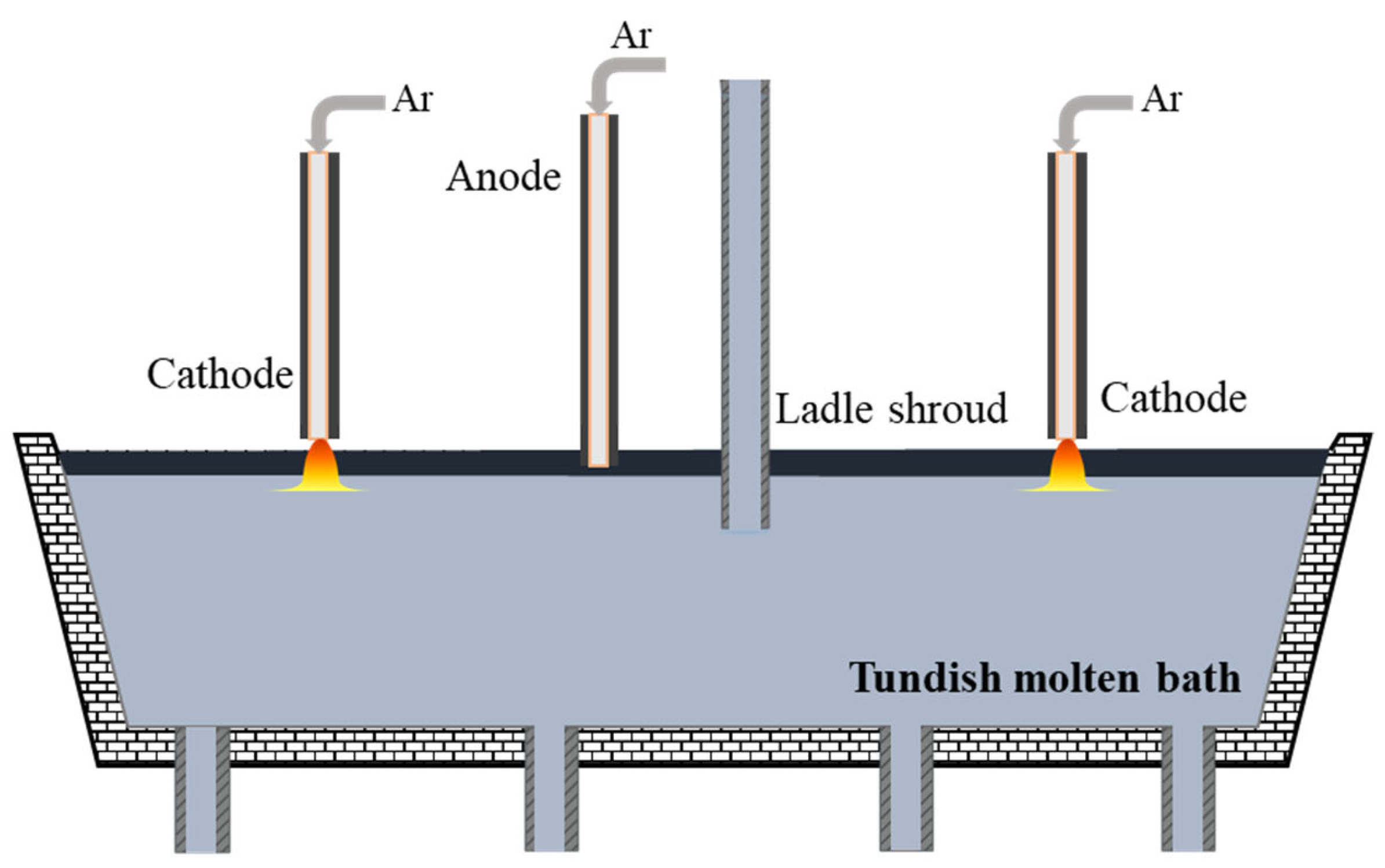
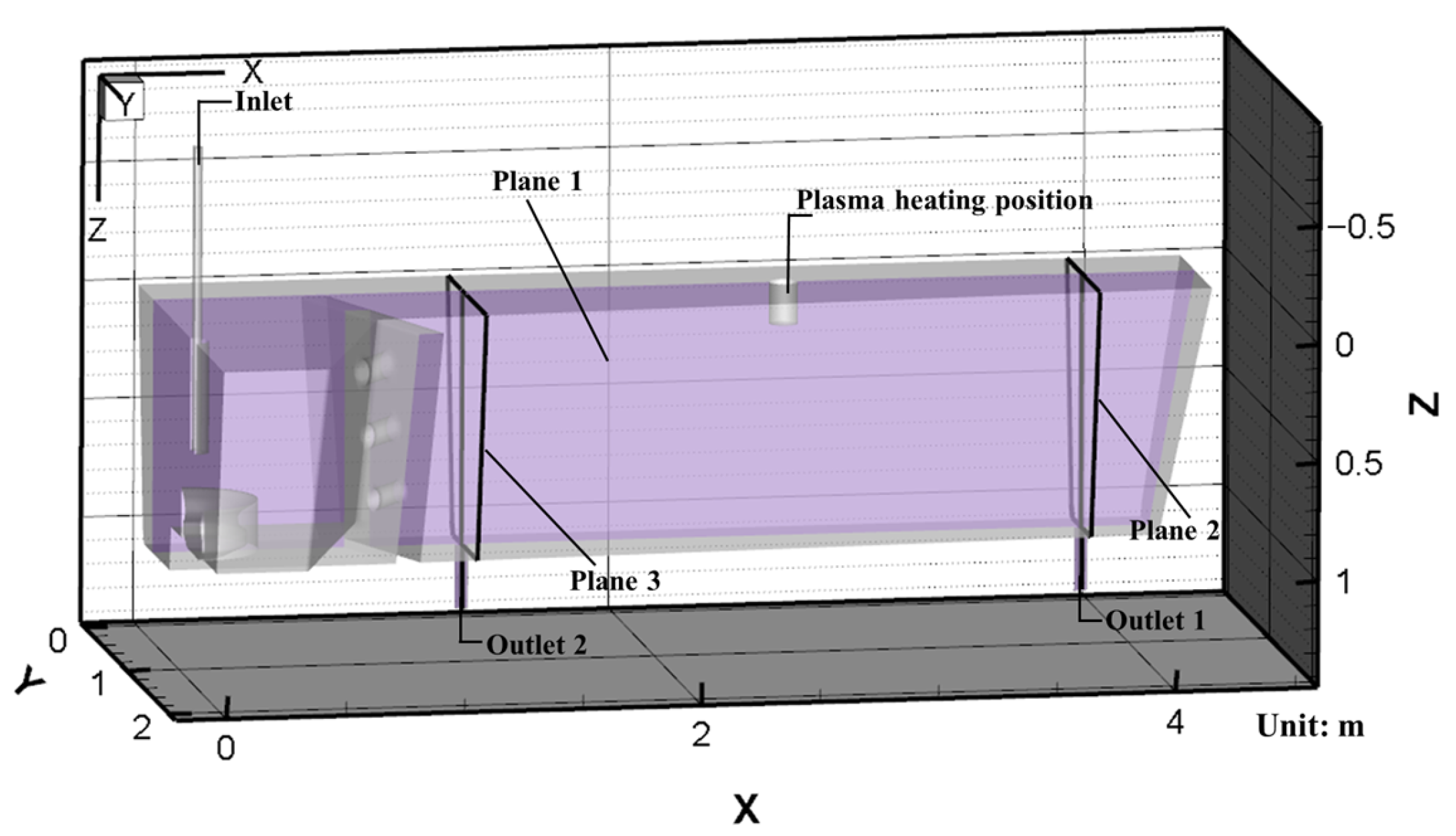
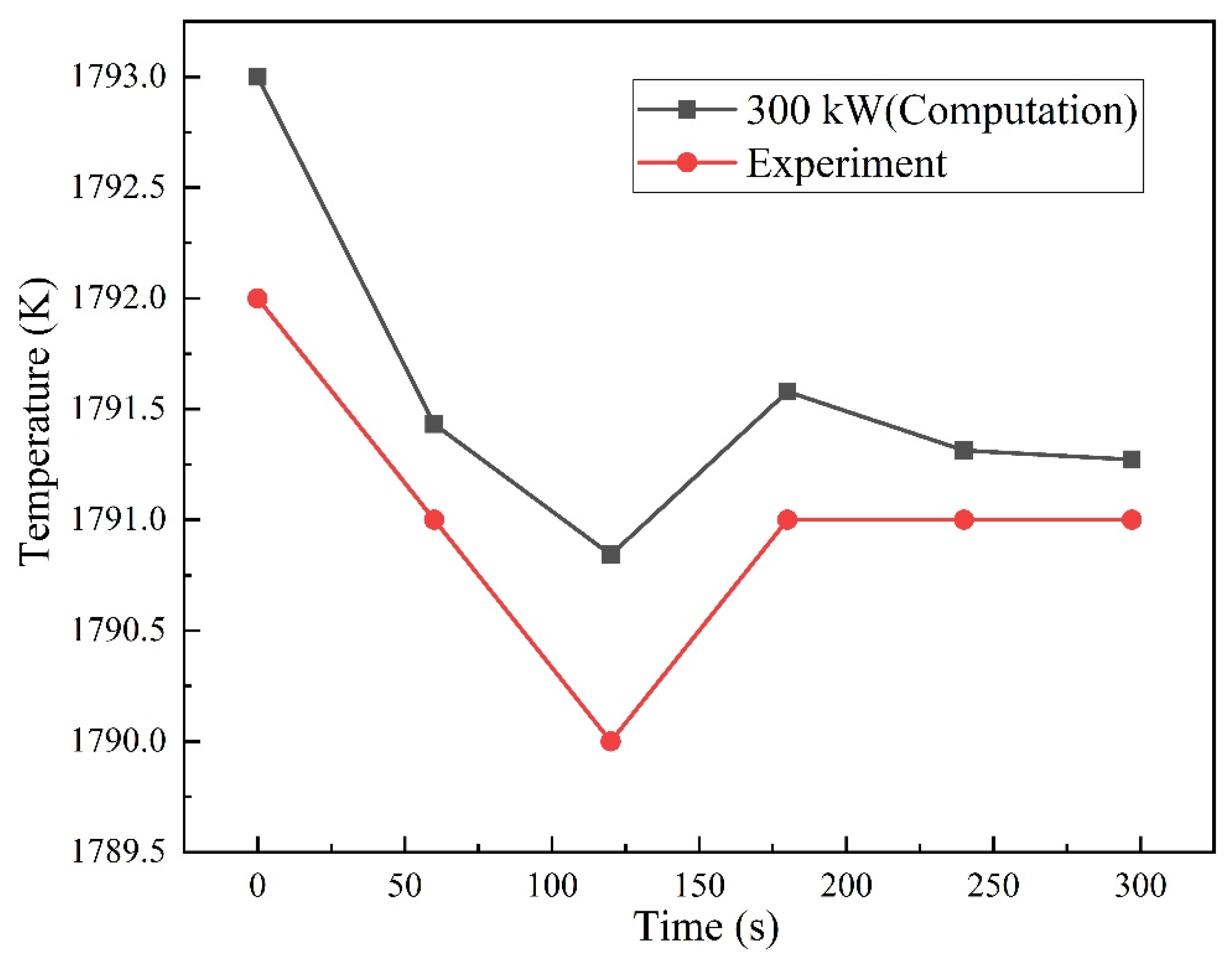
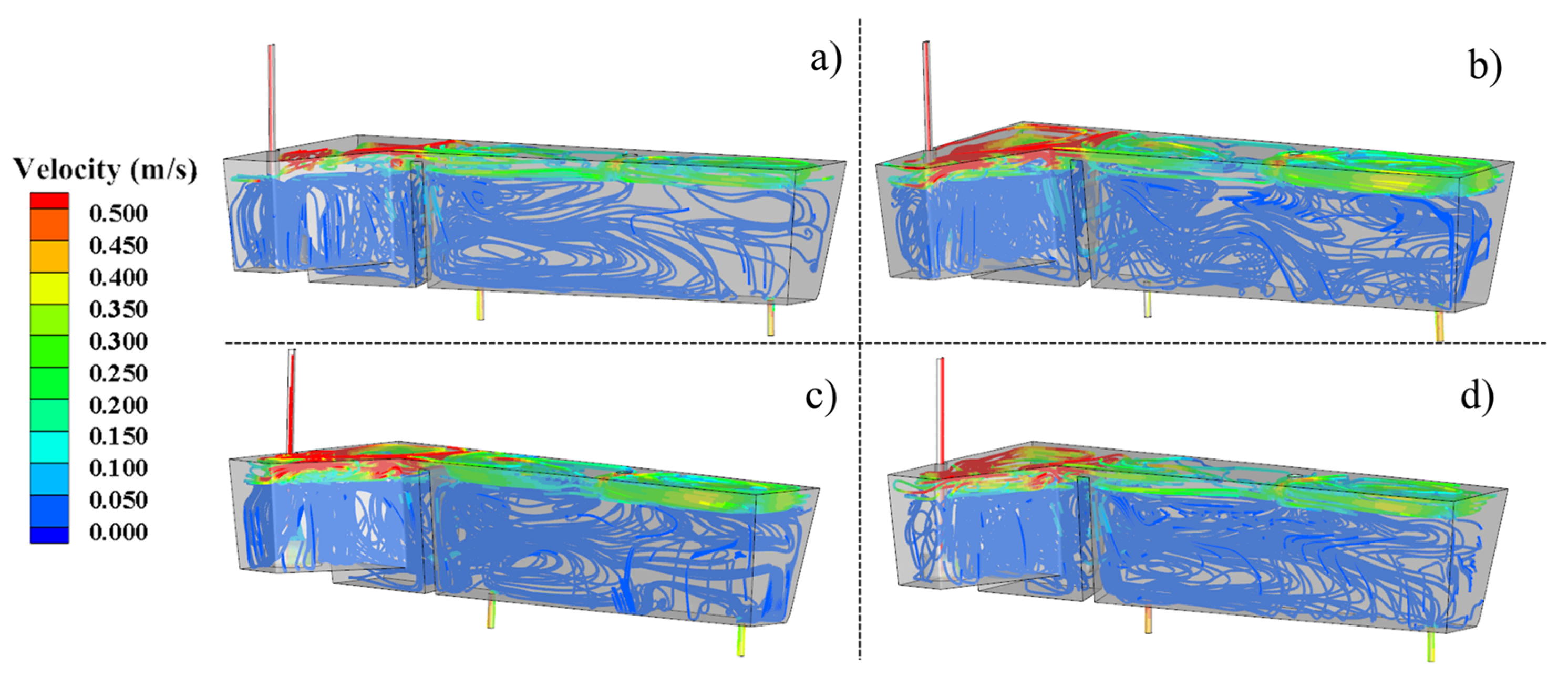
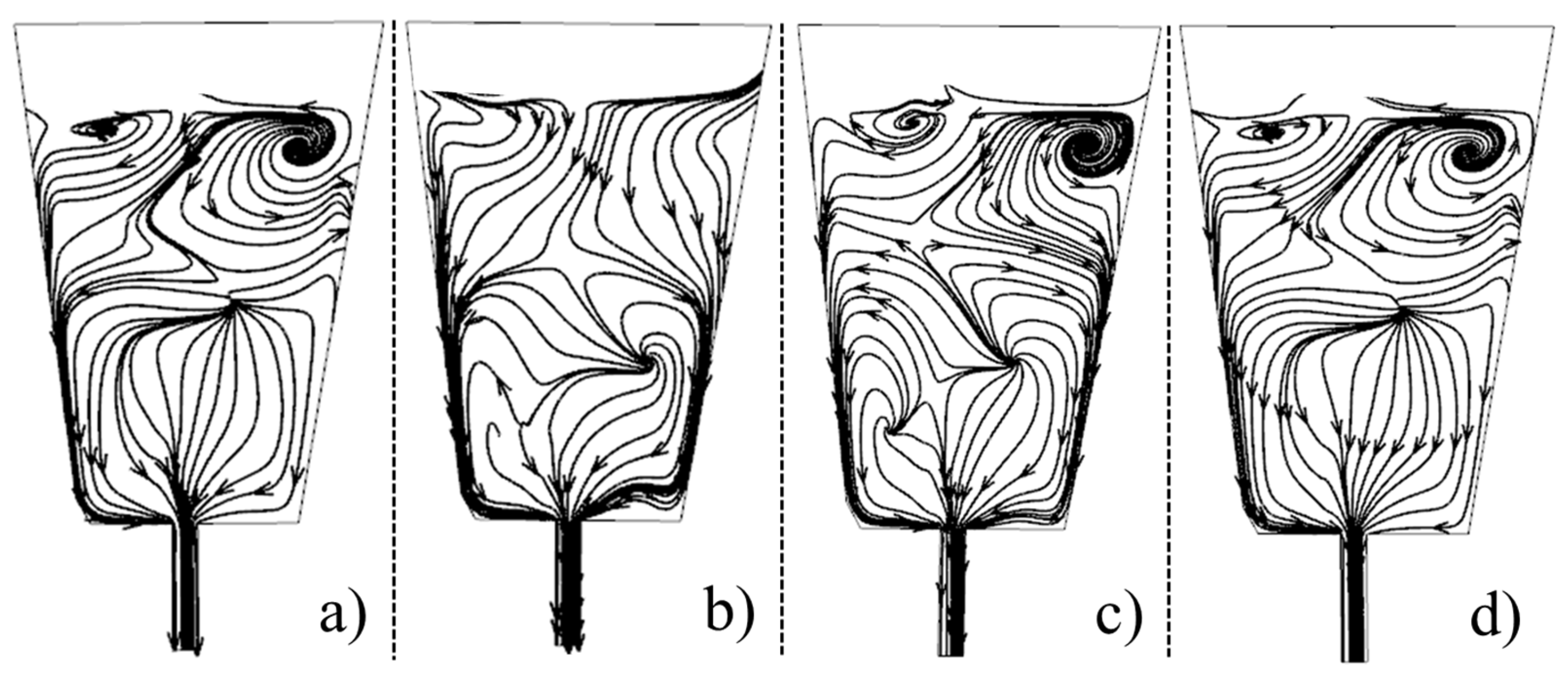

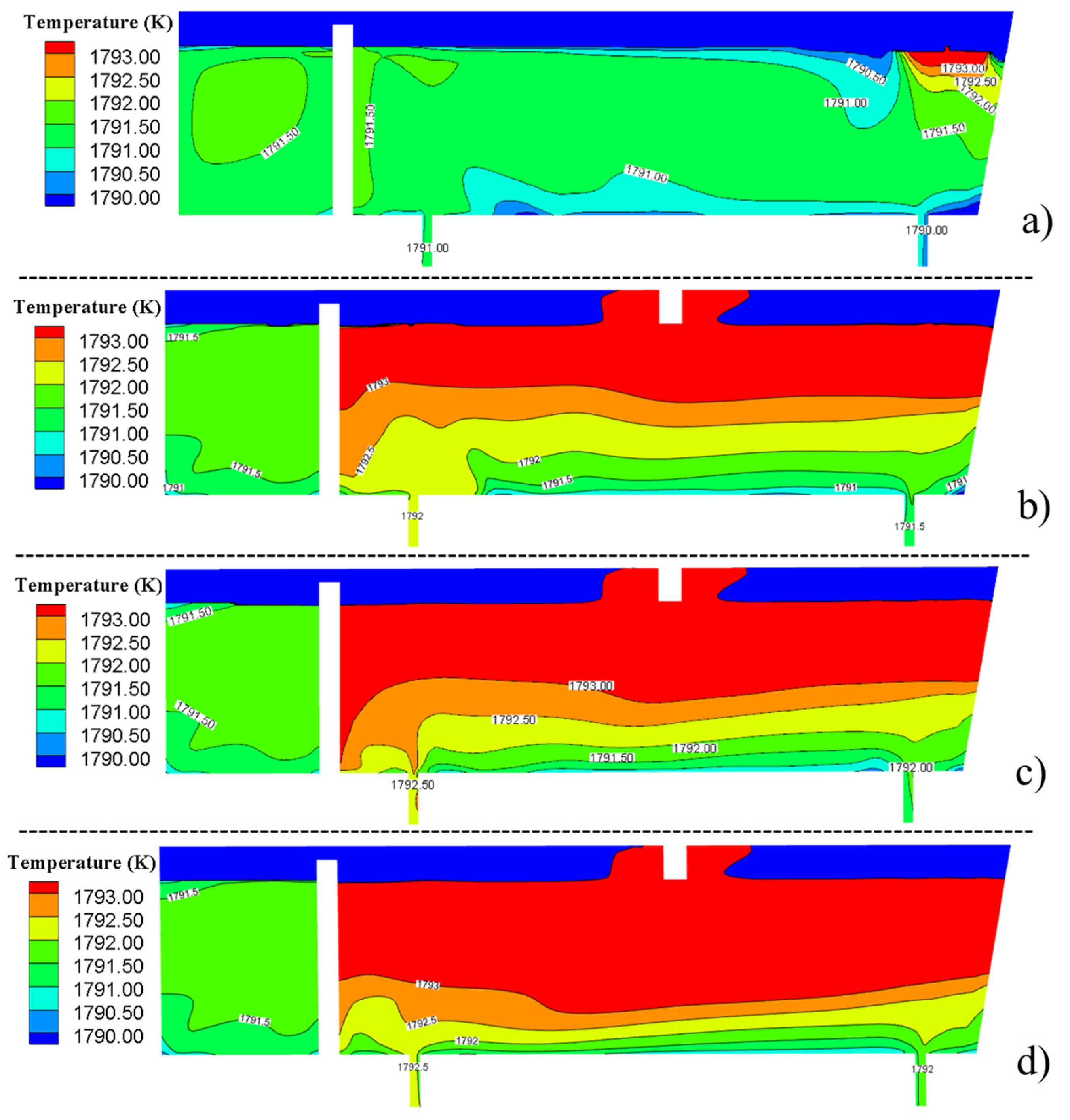
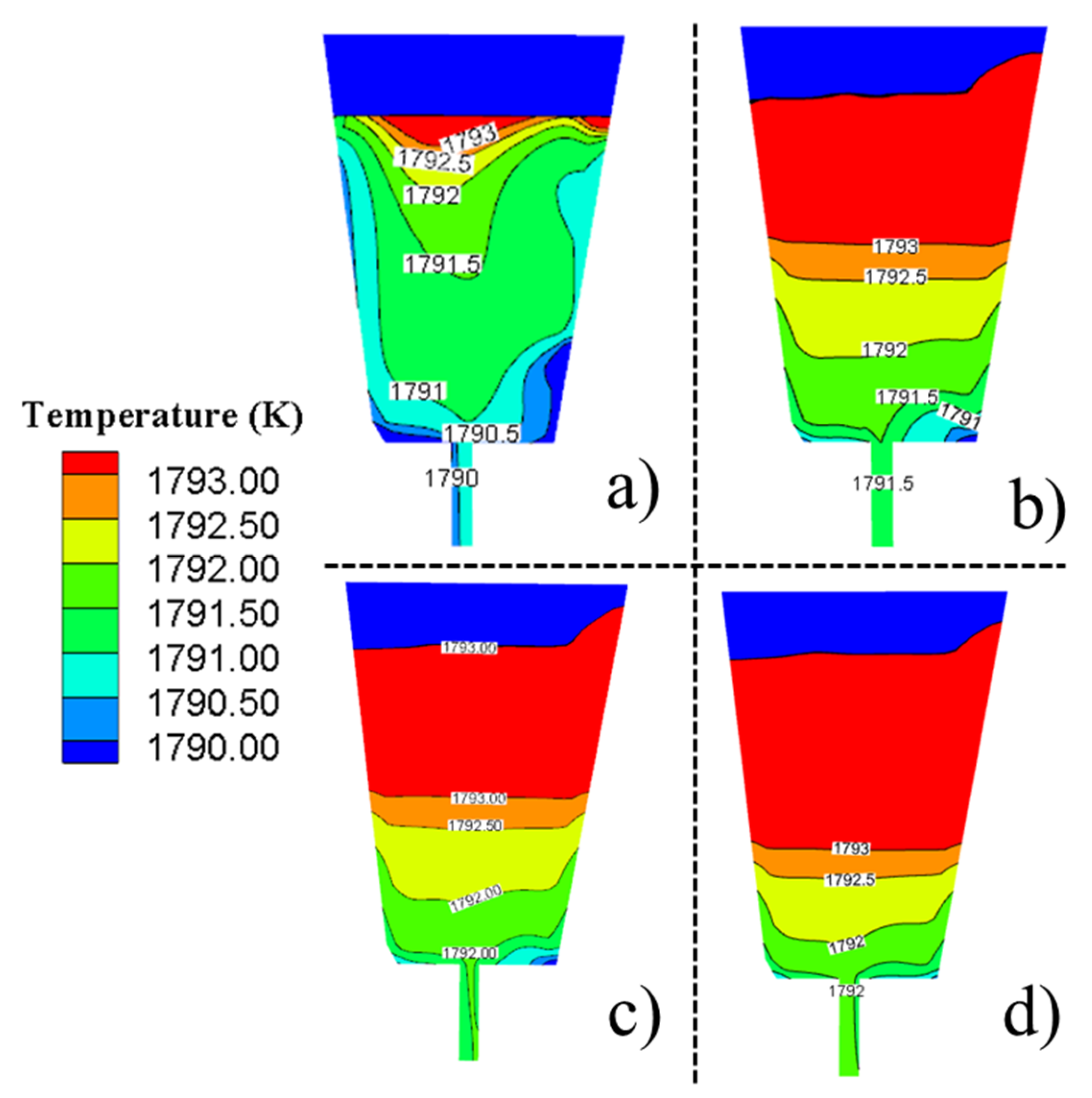
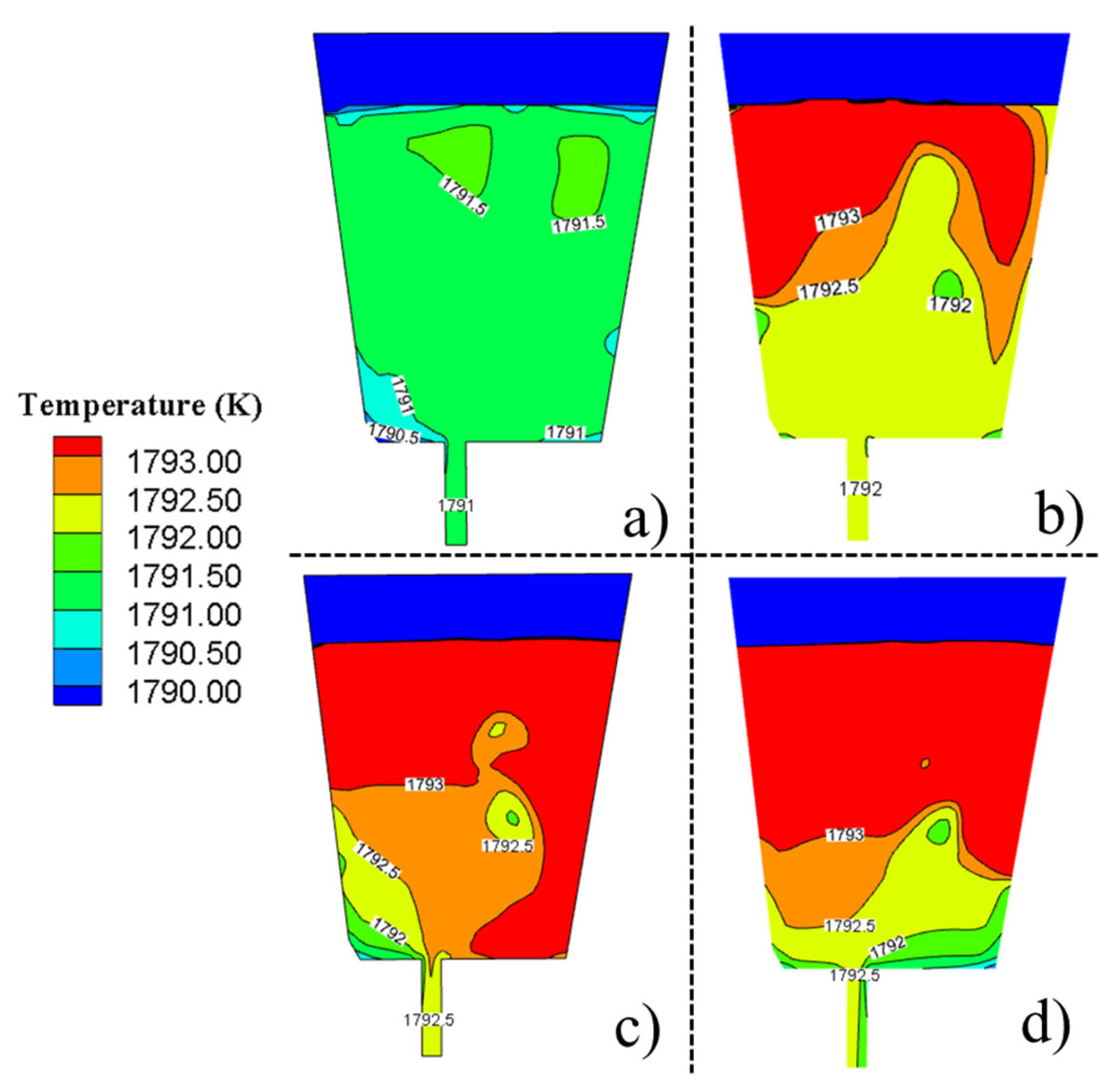
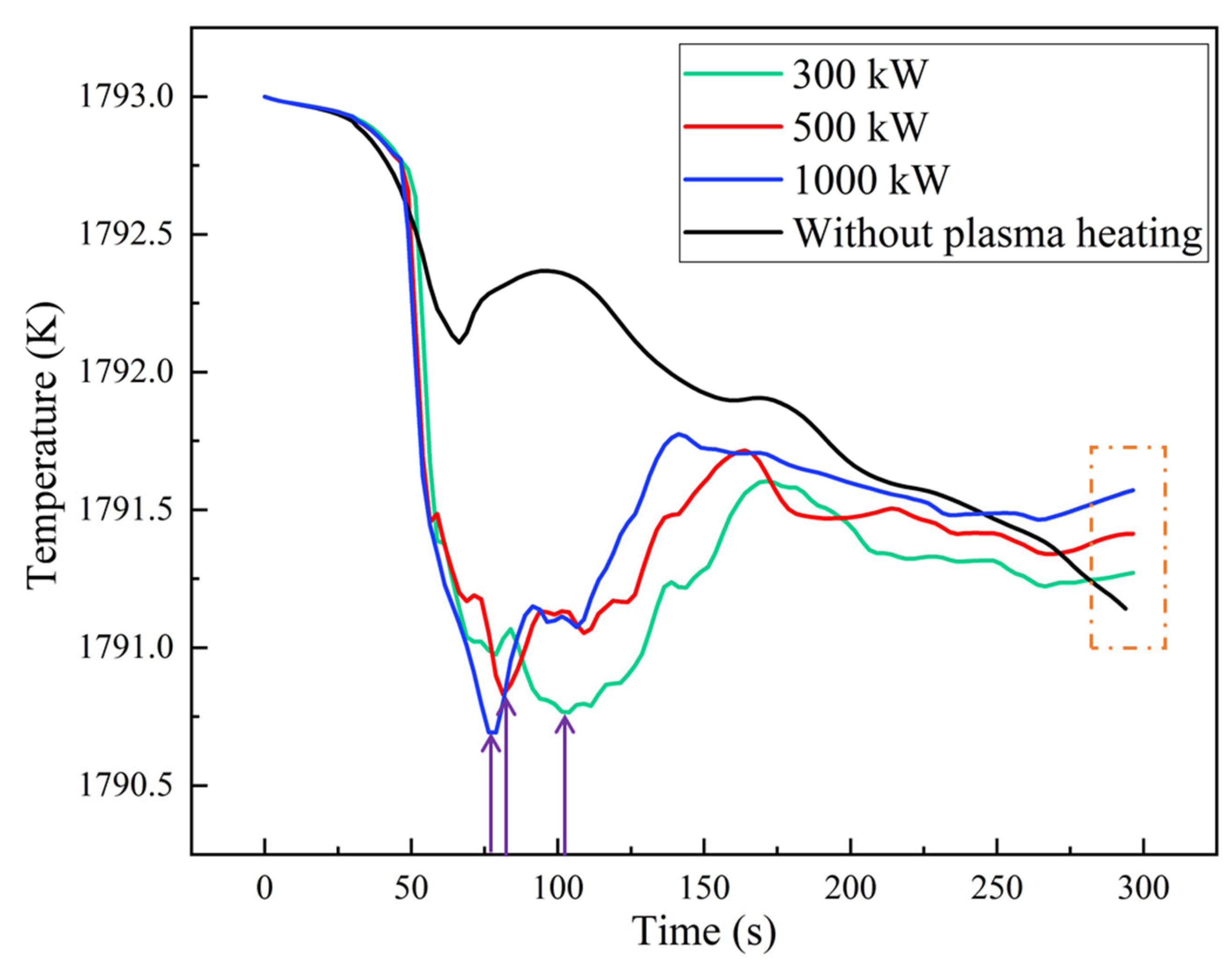

| The Main Parameters | Value/mm |
|---|---|
| Top Width of tundish | 762.9 |
| Bottom width of tundish | 427 |
| Top length of tundish | 4376 |
| Bottom length of the tundish | 4187 |
| Ladle shroud diameter | 70 |
| Tundish height | 1070 |
| Immersion depth of ladle shroud | 470 |
| Tundish working liquid level height | 900 |
| Casting speed (m/min) | 0.4 |
| Description | Value |
|---|---|
| Bottom wall heat flux | 1800 (W·m−2) |
| Top wall heat flux | 15,000 (W·m−2) |
| Longitudinal walls heat flux | 4200 (W·m−2) |
| Transversal walls heat flux | 4000 (W·m−2) |
| Plasma heating power | 300 kW/500 kW/1000 kW |
| Density of molten steel | 8523–0.8358 T (kg·m−3) |
| Density of argon | 1.6228 (kg·m−3) |
| Viscosity of molten steel | 0.0061 (kg·m−1·s−1) |
| Viscosity of argon | 0.0000212 (kg·m−1·s−1) |
| Thermal conductivity of molten steel | 41 (W·m−1·k−1) |
| Thermal conductivity of argon | 0.0158 (W·m−1·k−1) |
| Specific heat of molten steel | 750 (kg·m−1·s−1) |
| Specific heat of argon | 520.64 (kg·m−1·s−1) |
| Initial temperature of molten stee | 1793 K |
| Calculation time | 5 min |
Publisher’s Note: MDPI stays neutral with regard to jurisdictional claims in published maps and institutional affiliations. |
© 2021 by the authors. Licensee MDPI, Basel, Switzerland. This article is an open access article distributed under the terms and conditions of the Creative Commons Attribution (CC BY) license (https://creativecommons.org/licenses/by/4.0/).
Share and Cite
Zhao, M.; Wang, Y.; Yang, S.; Ye, M.; Li, J.; Liu, Y. Flow Field and Temperature Field in a Four-Strand Tundish Heated by Plasma. Metals 2021, 11, 722. https://doi.org/10.3390/met11050722
Zhao M, Wang Y, Yang S, Ye M, Li J, Liu Y. Flow Field and Temperature Field in a Four-Strand Tundish Heated by Plasma. Metals. 2021; 11(5):722. https://doi.org/10.3390/met11050722
Chicago/Turabian StyleZhao, Mengjing, Yong Wang, Shufeng Yang, Maolin Ye, Jingshe Li, and Yuhang Liu. 2021. "Flow Field and Temperature Field in a Four-Strand Tundish Heated by Plasma" Metals 11, no. 5: 722. https://doi.org/10.3390/met11050722
APA StyleZhao, M., Wang, Y., Yang, S., Ye, M., Li, J., & Liu, Y. (2021). Flow Field and Temperature Field in a Four-Strand Tundish Heated by Plasma. Metals, 11(5), 722. https://doi.org/10.3390/met11050722





